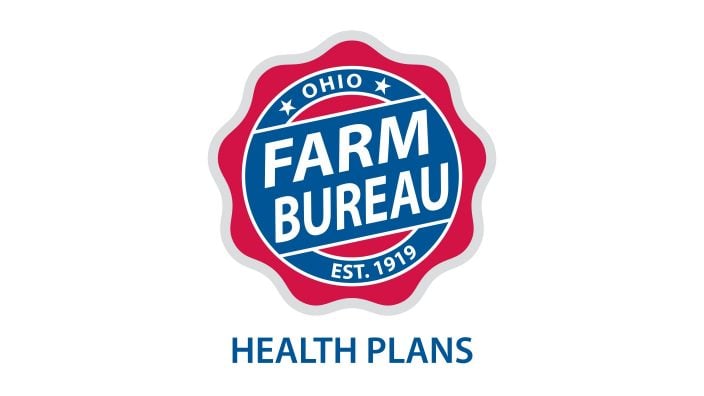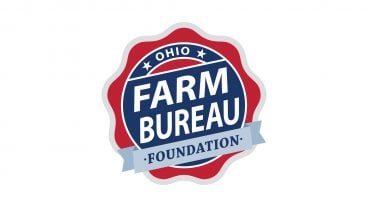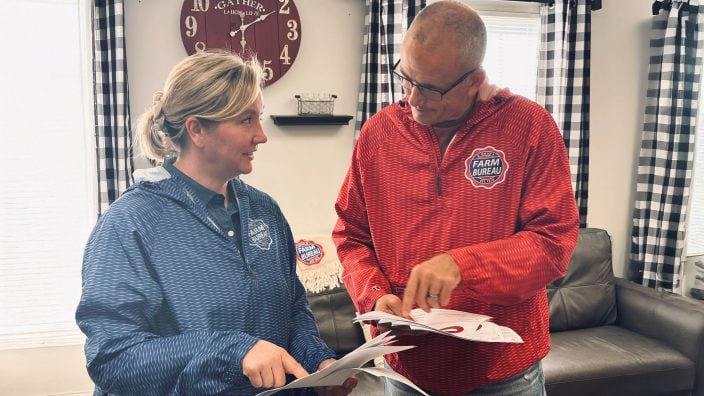Applications for Ohio Farm Bureau Health Plans now available
Members have three ways to apply: contacting a certified agent, calling 833-468-4280 or visiting ohiofarmbureauhealthplans.org.
Read MoreStudents at Ohio State’s CFAES Wooster campus enrolled in the “Intro to Beef Production” course this fall semester were the very first to work in the school’s latest addition to their cattle facilities.
Back in 2012, the Ohio State University College of Food, Agricultural, and Environmental Sciences’ Wooster Campus made local headlines as the newly installed handling facility, designed by the world-renowned animal behaviorist Temple Grandin, PhD, was dedicated. This handling system was a major asset to the college’s beef and livestock program students.
The state-of-the-art working area is complete with a dual hydraulic squeeze chute system, breeding box and sorting pens made with Grandin’s curved chute design for humane and consistent cattle movement. This system is similar to other types Ohio State ATI students can expect to encounter with different cattle careers all over the country.
“I think the new facility has a very good setup in terms of low-stress management on the animals and having easier access to move them,” said ATI freshman Cheyenne Heffner. “Although I’ve never had to use the old beef facility but once, I think this is a great improvement for the beef students and staff.”
To further enhance this layout, a new monoslope-style building, among the latest innovations in cattle feedlot design, was made operational in late spring 2020. This facility sits alongside the handling system, allowing students to safely and humanely move animals through as they are brought up from the pasture, worked on and sorted into the barn.
The building is designed for both maximum animal welfare and practicality, allowing students even more of the hands-on, real-world style of education ATI is known for. This also opens up more opportunities for advanced research trials to be conducted involving cattle feeding, something the old facilities weren’t quite equipped to do.
“This will also allow us to do a lot more with classes as far as feedlot-related topics,” said Michael Amstutz, PhD, professor and coordinator of ATI’s livestock programs. “We’ve recently taken some of the steers and heifers in the feedlot and implanted them so the students can do a little trial and see the effect of implanted and nonimplanted animals.”
Students also gain experience with more diverse management practices and get an opportunity to practice real-life skills they will need to be employed in the beef industry working in similar facilities.
The monoslope building is made for Ohio’s weather conditions. Before the facility was built, CFAES looked at multiple similar facilities around the state being used as feedlot barns or housing for high-risk calves before sale. The concrete base and sloped roof protect against the hazardous Midwestern elements and muck buildup.
“The cattle have been doing exceptionally well, and I think that’s attributed to ventilation and environment,” Amstutz said. “The design of the barn is such that it maximizes summer ventilation and also allows winter sunlight to penetrate further into the facility to help warm the environment.”
Cattle were first moved in May 18, 2020. The barn is designed with enough room to house the entire herd for part of the year, either 100 cow and calf pairs or 100 head of feedlot cattle. In the winter, the staff plans to shift usage from a feedlot to housing mother cows and calves. This will save wear and tear on the pasture during the harsher weather conditions and allow for more optimal forage and pasture management. After the spring calving season, weaned animals will be moved in as a feedlot setup.
Additional accommodations for students include a shower and locker area, a built-in foot wash station and a heated, indoor washroom. This area will be used to prep show calves for events such as the Ohio Beef Expo where ATI’s purebred Angus and Murray Gray cattle compete annually.
Another exciting future opportunity is a collaboration with researchers also on the CFAES Wooster campus. There is discussion to invest in the GrowSafe feeding systems, which are specialized feeders that use advanced technology to monitor feed intake for research and data collection. Amstutz said this would allow researchers to monitor performance on an individual cattle basis instead of per pen.
This recent update reflects CFAES’ ongoing commitment to invest in their students and programming.
Besides providing students with a safe and comfortable environment to study, they are also learning skills applicable to what they can expect to encounter with their future agricultural careers.
Photos by Dave Gore
Photos submitted by Ohio State University


Members have three ways to apply: contacting a certified agent, calling 833-468-4280 or visiting ohiofarmbureauhealthplans.org.
Read More

The American Farm Bureau Federation County Activities of Excellence awards celebrate unique, local, volunteer-driven programs.
Read More

The scholarship provides one renewable award of $10,000, supporting a student pursuing a degree in agriculture or an agriculture-related field.
Read More

A short conversation over the phone, a quick text message or even finding a small daily habit such as journaling can make a big difference.
Read More

One of the best decisions Shannon and Heather Utter made a few years ago was looking into a Farm Bureau member benefit that has ended up saving them thousands of dollars on their energy bills.
Read More

Ryan Hiser has experienced first-hand the importance of having the opportunity to vote on issues that will affect his family operation and other farmers.
Read More

Bill Patterson, Cy Prettyman and Adele Flynn will continue to serve as officers for Ohio Farm Bureau Federation.
Read More

Delegates discussed many topics impacting agriculture including farmland preservation, local foods, and succession planning.
Read More

Twenty-six farmers govern the state’s largest farm and food organization.
Read More

The 2025 recipients are Fred Cooke (posthumous) of Richland County, Marvin Dietsch of Williams County, Steven Knollman of Hamilton County and Michele Miller (posthumous) of Ottawa County.
Read More